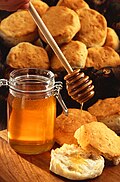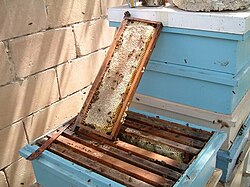Honey
Honey is a food made by honeybees from nectar. They put the honey into a honeycomb, which for them is a storage unit. Honey is sweet and can be used instead of sugar. It is a supersaturated liquid. As the temperature drops, glucose comes out of solution. Then it is a semi-solid rather than a liquid.
Honey is first mentioned in the Book of Exodus, and is often linked with pleasant and comfortable things. "Land of Milk and honey". It is also referenced in the Qur'an, with similar associations to good and evil.
The name honey is derived from the Old English 'huniġ'.[1]
Much like wine, there are several kinds of honey with different tastes, colors and textures. Some common types are got from bees who use the clover flower's pollen. It is thick and has a medium color. It tends to form crystals or grains more quickly when exposed to air. Acacia flowers make another common variety.
Honey from bees using flowers from oleanders, rhododendrons, some laurels, and azaleas may cause honey intoxication. Symptoms include dizziness, weakness, sweating, nausea, and vomiting.
Expert beekeepers solve this problem by moving their hives to areas where the right flowers are available. Bees like to get their nectar locally, and do not go more than two miles from the hive.
Honey tastes quite different according to which flowers the bees used. Key things are its smell, taste and how clear it is; also no bad qualities.
Most microorganisms cannot grow in honey and a honey that's packed therefore does not get spoiled. Samples of honey discovered in archaeological contexts in Egypt and some other countries have proven that honey is perfectly edible even after thousands of years.[2][3]
Classification
Source of flower
Honey can be classified by the type of flower that the bees make the honey from.
Blended
Most commercially available honey is a mixture of two or more honeys that differ in the source of the flower, color, flavor, density, or geographic origin.
Polyfloral
Polyfloral honey, also called wildflower honey, is gotten from the nectar of many types of flowers. The taste may be different from year to year, and the smell and the taste can be more or less powerful, depending on which flowers are blooming.
Monofloral
Monofloral honey is made mainly from the nectar of one type of flower. To make monofloral honey, beekeepers keep beehives in place where the bees have access, as far as possible, to only one type of flower. However, a small amount of any monofloral honey will be from other flower types.
Classification by packaging and processing
Honey can be classified by packaging and processing.
- Crystallized honey: Crystallized honey is when some of the glucose content has immediately crystallized from the mixture as the monohydrate. It is also called "granulated honey" or "candied honey". Honey that has crystallized can become liquid by warming.
Gallery
Worldwide production
| Production of natural honey – 2017 | ||
|---|---|---|
| Country | tonnes | |
| 543,000 | ||
| 114,471 | ||
| 69,699 | ||
| 66,968 | ||
| 66,231 | ||
| 65,678 | ||
| 64,981 | ||
| World | 1,860,712 | |
| Source: FAOSTAT[4] | ||
In 2017, the world produced 1.9 million tonnes of honey. China produced 29% of the world total. Other major producers were Turkey, Iran, United States, and Ukraine.[4]
Honey Media
Honeycomb displaying hexagonal prismatic wax cells in which honey bees store honey
A variety of honey flavors and container sizes and styles from the 2008 Texas State Fair
References
- ↑ Nast, Condé (14 February 2013). "The Origin of the Word 'Honey'". Bon Appétit. Retrieved 24 October 2023.
- ↑ Colangelo, Harmony (3 March 2023). "The World's Oldest Jar Of Honey Is From 3500 BC".
- ↑ Geiling, Natasha (22 August 2013). "The Science Behind Honey's Eternal Shelf Life". Smithsonian Magazine.
- ↑ 4.0 4.1 "Production quantity of honey (natural) in 2017, Livestock Primary/World Regions/Production Quantity from picklists". Food and Agriculture Organization of the United Nations (FAO). 2018. Retrieved 18 March 2019.
Other websites
| Wikimedia Commons has media related to Lua error in Module:Commons_link at line 62: attempt to index field 'wikibase' (a nil value).. |














